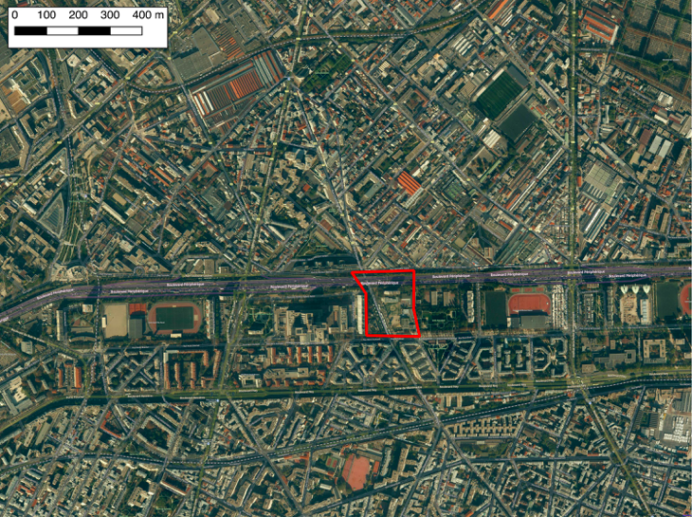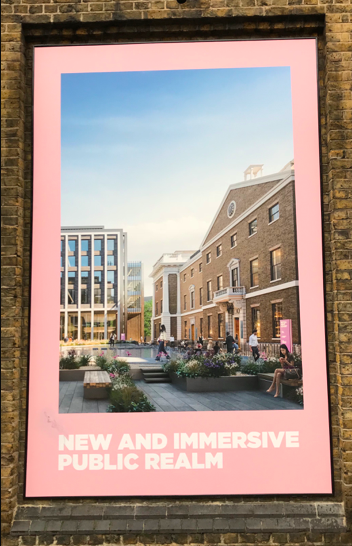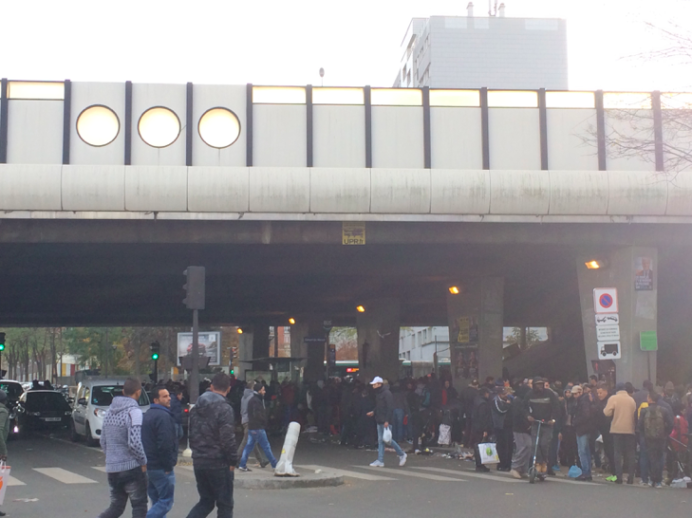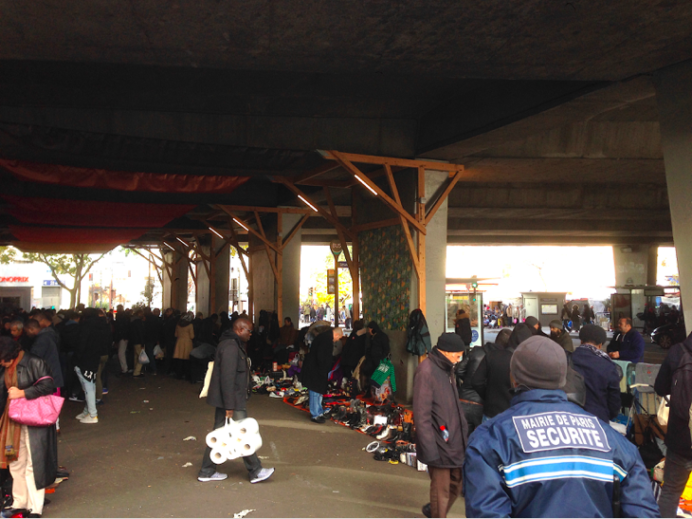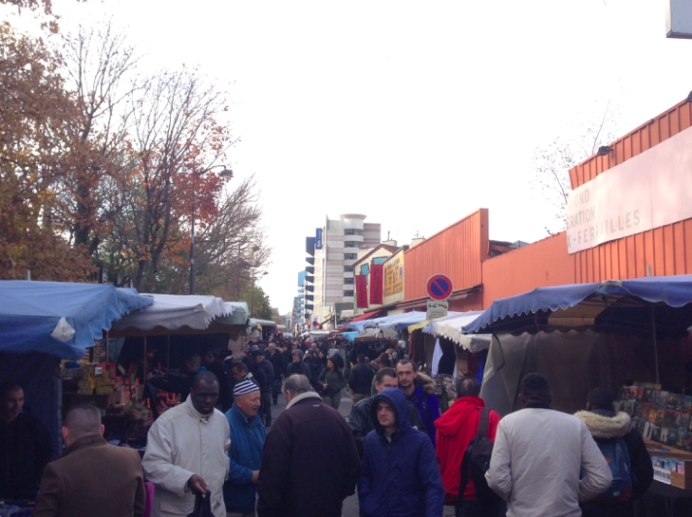I want to talk today about the idea of immersiveness as a quality of the public realm, how that might be formed, and what its social potential is. This starts from research I’ve been doing in Paris into the soundscape of the city’s periphery, that I’ll start by briefly introducing the work I’ve been doing focuses on the spaces around the périphérique, a motorway surrounding the city of Paris.
Introduction: reconquering the périphérique
The périphérique, following the line where the city’s walls once stood, that marks the political and physical separation between the city-proper and its surrounding cities and suburbs. For the first time there is a real attempt to integrate its suburbs into the metropolis as a single administration of Grand Paris – ‘greater Paris’ – encouraging social and political connection across this spatial divide. In doing so it is attempting to deal with this barrier that is such a powerful marker of social division, and which helps reproduce stereotypes about the banlieues that lie beyond it.
As part of this is what the city is describing as a reconquête urbaine – an urban reconquering – aiming to ‘erase’ the pérhiphérique through artistic and landscape interventions. By this, the city means a reclaiming of social space from this supposedly inhospitable, infrastructural environment. My interest started out as a response to this, to find out if and how these spaces were so antithetical to social life. And once I found out I was speaking in this conference, I’ve started to think about these places in relation to immersion.
Recently I also saw a fascinating poster (image 2), offering ‘new and immersive’ public realm. Being London, this public realm is actually part of a private development, but it struck me that immersion is something seen to be desirable for the public realm, even economically valuable. But this picture is trying to sell it based on an image, which by its nature filters out much of the sensory information that makes immersiveness. Which led me to ask: what does it mean to be immersed in the public?
Under the Périphérique
This is the porte de Montmartre (image 3), one of the spaces I looked at on the péripherique. You can see how it separates the urban fabric on both sides, creating a kind of no-man’s land. Based on a visual idea of what makes a good public space, you might agree with the city of Paris that this is a failed social space that needs reconquering to make it somewhere welcoming to public life.
What I want to share with you is a soundscape recording that starts underneath the flyover of the périphérique, in the chaotic informal flea market that has sprung up there, steps out into the cleaner, more formalised market along the street next to the motorway, and finishes out on the road leading back into Paris. By listening to the difference as our ears move through these spaces together, I want to highlight acoustic qualities of public spaces, moving beyond visual analysis of the public realm, which may be unstimulating to the eyes but rich for the other senses. And finally to say something about the social and political potential of how these acoustics affect the character of the forms of social life taking place within them.
In this space, the motorway covers over the road, offering shelter to the people that meet there to buy, sell, and exchange. But I think this enclosure does something else too – it reflects sources of sound – music and voices – back at themselves. Its reverberance that intensifies their presence. This leads to the dominance of human voices over traffic noise, and the combining of these voices into one sonic whole. Separate bodies in space become more like the singular mass of a crowd where individual voices can only occasionally be distinguished. I have to shout to make myself heard, and I am deeply immersed in the physical experience of being together, losing myself in the process.
In the open
As we find ourselves in the normal street market we are still amongst bodies but it no longer sounds like a crowd. Voices and music disperse rather than resonating together. The spaces between people become separating rather than connecting fabric. This is the kind of public that allows us to be alone together, to hear ourselves think, which is also important in cities as no one could tolerate being so immersed all of the time. But it’s interesting that whereas the space under the bridge is policed, this one is not. The crowd, as its noise is amplified, becomes a threat to the public order. Think about protests, that almost always use chants and drums to make unified noises that show the collective power of people in the street. The bridge creates some of this condition, operating like a theatrical public the amplifies the power of the human voice, whereas the market outside is more like the polite soundscape of the everyday street.
Finally, on the road leading back from the périphérique into Paris, just inside the porte de Montmarte, we are mostly alone, accompanied by traffic and the occasional passer-by. This highlights that soundscape, if it can be an immersive quality of place, is not something that simply exists but is constantly produced through our use of places. Sound can only happen when things move or act, which is why it cannot be captured in a picture that freezes time. The soundspace of a space is not a thing, but a relationship between human action and the acoustic properties of an environment. We are always immersed in its product but also always in its production, in a way that we cannot always immediately change what can be seen. In a sense, it is how the static built environment responds to our presence in it, in different ways depending on how it is designed.
In this small example, the simple feature of a motorway bridge over the street takes what would otherwise be an unremarkable gathering of people and turns it into a rich and immersive public space. In this way, architecture intervenes actively in the social world to intensify its character. So when we’re thinking about how to design spaces that interact with and engage their users, it’s worth remembering that the form of that interaction may not always be visible, but could be the invisible way it transform at a distance the sounds we make with our bodies.
Acoustics as Social Infrastructure
By changing the way we hear one another, acoustics become deeply political. Whether we perceive ourselves to be an isolated individual amongst many, or part of the larger whole of a crowd, is transformative for what we understand the public realm to be for. Whilst many can pay for these experiences of immersion in a crowd – at a concert, club, or installation art work – many are excluded socially and economically from this kind of cultural spectatorship. Urban design, even in unexpected ways, can provide, for free, every day, rich sensory experiences that plunge people temporarily into the immersive presence of others, taking them briefly outside of their inner subjectivity.
A similar space, though, can also amplify machine noise to a threatening level, acting as a reminder that the resonance I’m talking about is not of value in its own right, but a potential to intensify the effect of the way we use spaces in the city.
This text is from a presentation given on Saturday 20th January 2018 at the conference Into Worlds: the Craft of Blurring Boundaries, which took place at Martin-Gropius-Bau, Berlin, as part of the Berliner Festspiele. It is based on work undertaken on a Postdoctoral Fellowship under the Global Cities chair at the Collège d’études mondiales, FMSH, Paris, linked to the creation of Atelier TM.
